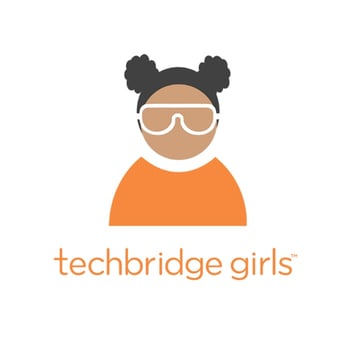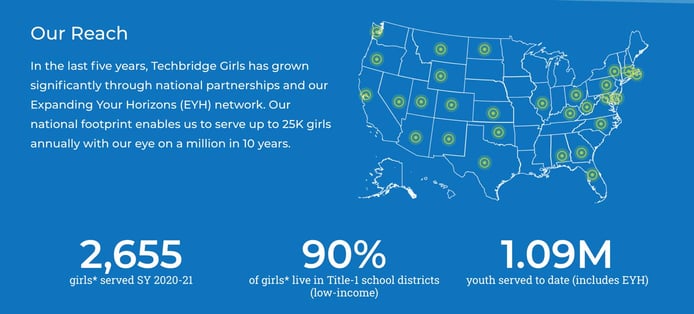
TL; DR: Techbridge Girls has long encouraged STEM programs for Black Indigenous (BIPOC), and all girls of color from marginalized communities, and 2020 was a crucial year for the organization. From a direct service model in three cities to a national leader in developing STEM equity education across 20 states, Techbridge Girls aims to use strategic partnerships and digitization to scale up and expand its reach and impact.
Nikole Collins-Puri, CEO, has led Techbridge Girls with a spirit of leadership and perseverance, especially in the face of adversity. And there’s plenty of adversity when it comes to changing the conversation around STEM education for girls.
Techbridge Girls aims to reengineer STEM education for BIPOC girls and gender expansive youth who experience economic insecurity and are often left behind and out of the STEM revolution. According to the organization, many STEM programs are white and male-centric, focus on rote learning, and exclude information on the contributions of women of color.
Techbridge Girls challenges gender, racial, and class bias in STEM fields and culture by developing gender responsive and culturally relevant STEM curricula that helps girls see their unique STEM lineage, community, interests and path to success. It offers training and resources to equip out-of-school time educators and STEM professionals on power imbalances and helps them implement culturally relevant practices when engaging BIPOC girls in STEM.

For over twenty-years, Techbridge Girls is leading the charge fearlessly even in the midst of so much uncertainty and unrest in our country. According to the organization’s founder Linda Kekelis, leading fearlessly doesn’t mean not being fearful.
“I think it means acting in the face of fear, being able to confront fear and get through it, and recognizing that it can be uncomfortable and scary and hard. That’s kind of how girls have to be in a Techbridge Girls program — you can have that feeling but not let it hold you back from doing things,” she wrote on the Techbridge Girls website.
That ability to confront fear and thrive was key to getting through 2020, and CEO Nikole Collins-Puri said the COVID-19 pandemic accelerated our new strategic direction and focus on the systems, representation, and pedagogy that prevents girls from persisting and thriving into STEM fields.
The pandemic, along with a renewed focus on racial inequality in America, sent the organization’s mission into overdrive. That mission is apparent in the Techbridge Girls tagline: Re-engineering STEM education for girls.
“We went from having conversations explaining why STEM equity was so important to getting straight to the work on making change across our field and industry,” Nikole said.
Shifting to a Scalable Model During the COVID-19 Pandemic
Even before the pandemic, Techbridge Girls was well down the path in scaling its model nationwide from expanding it’s programming across Californa, Pacific Northwest and DC Metro Area to the acquisition of a 45-year old girl serving national nonprofit, called Expanding Your Horizon Network.
“We’re evolving as an organization. We have been known as a direct service organization an now becoming a STEM equity leader in system change for our field,” Nikole said. “We’re using what we know is happening on the ground and translating that to ‘How do we scale for transformation?’”
The growth plan is three-fold and includes digitization, economy of scale, and a deepened focus on equity. “COVID-19 affirmed our new strategic direction,” Nikole said. “We moved into a partner model providing others with our Techbridge Girls programming, training, resources, and materials to deliver it.”

Digitization has played a critical role in delivering through our new partner model. Technology allowed us to reach more girls, equip more educators, and be more efficient as an organization to do the work.
Digitization became crucial during the COVID-19 pandemic.
In 2020, the country also saw a racial justice reckoning, and Techbridge Girls was poised for this moment because of what it has fought for over the last two decades.
Nikole said that, with so much focus on racial inequality, it was a perfect avenue to amplify the experiences of our girls, talk about the systemic issues rooted in the lack of representation in the field and celebrate the brilliance of women of color who are often left out of the STEM revolution stories. This also generated a movement of opportunity to engage partners in our journey to transform our field.
Community Partners Help Ensure Success
Partnerships play a crucial role in Techbridge Girls as it continues to grow. Two of its most impactful alliances are with the Million Girls Moonshot initiative, which is connected to the STEM Next Opportunity Fund and Intel, and the National Society of Black Engineers’ SEEK summer camps.
“The Million Girls Moonshot initiative supports 50 statewide STEM networks where we are providing our curriculum and our training to those networks to increase the quality of STEM education for girls,” Nikole said.
According to the Techbridge Girls website, the NSBE Summer SEEK camp is aimed at African Americans and other student groups underrepresented in STEM. However, the partnership created a program specifically for middle-school girls across four cities leveraging Techbridge Girls expertise in engaging middle-school girls of color.

“The SEEK camp model exposes students to basic STEM concepts; establishes a foundation of STEM knowledge, and experience that students can build upon in middle school, high school, and college; and, ultimately, increases the number of Black professionals in engineering,” reads a post on the Techbridge Girls website. “Becoming involved in these well-known entities has allowed for Techbridge Girls’ to scale its equitable STEM programming focused on Black, Indigenous and all girls of color to new states across the country.”
Along with national partnerships, Techbridge Girls also works with school districts and community-based organizations on the city, state, and regional levels, including Girls, Inc. groups and Boys and Girls Club branches. Making connections at every level is an integral part of the organization’s mission to help BIPOC girls from marginalized communities to pursue and persist go into STEM fields.
Fueling the Vision of a Digital Future
Nikole said digitization was always one of the keys to success for Techbridge Girls. The pandemic just helped catalyze and focus its effort.
Now the organization can disseminate its curriculum and training materials to partners and stakeholders around the nation. It has helped change the Techbridge Girls model from a direct service to becoming a leader in driving action and promoting STEM equity with those who have the ability to influence and accelerate girls’ STEM aspirations.
And the results of its latest push are already showing.
Nikole said Techbridge Girls is on track to serve approximately 6,000 girls in 2022. That’s about double the number it helped in 2021. In addition to serving girls, out-of-school time educators and STEM professionals, the organization can now spread its message and activate its growing community toward its mission.
Digitization — from a redesigned website to its digital hub (portal for curricula and training materials)— will continue to play a critical part of the organization’s role in leading the STEM equity conversation. It will also help in developing equity educators who are better equipped to support our girls brilliance and STEM aspirations.
Techbridge Girls: Extending Its Reach and Developing Equity Educators
Nikole’s passion for the Techbridge Girls mission is evident when she speaks about what the organization is doing and what its future holds. Its goal is to reach 1 million girls by 2030.
“We are on the path. We have opportunities that, if they come to fruition, will truly accelerate our ability to reach that goal,” Nikole said. “We laid a strong foundation, have a track record with putting our girls at the center and know what needs to happen for our girls to thrive in the STEM revolution.”
“We understand that we cannot achieve this goal with out financial support, industry expertise and partnership. The pandemic allowed us to fuel the vision but we must sustain it,” Nikole said.
Techbridge Girls aims to empower a generation of BIPOC girls from marginalized communities by equipping out-of-school-time educators and STEM professional with curricula and training so that girls can thrive and persist in IT, hosting, or any of a variety of technological or mathematical fields.
Even though 2021 was a challenging year, it affirmed Techbridge Girls 20-year journey of its work and has propelled them into their next chapter.
HostingAdvice.com is a free online resource that offers valuable content and comparison services to users. To keep this resource 100% free, we receive compensation from many of the offers listed on the site. Along with key review factors, this compensation may impact how and where products appear across the site (including, for example, the order in which they appear). HostingAdvice.com does not include the entire universe of available offers. Editorial opinions expressed on the site are strictly our own and are not provided, endorsed, or approved by advertisers.
Our site is committed to publishing independent, accurate content guided by strict editorial guidelines. Before articles and reviews are published on our site, they undergo a thorough review process performed by a team of independent editors and subject-matter experts to ensure the content’s accuracy, timeliness, and impartiality. Our editorial team is separate and independent of our site’s advertisers, and the opinions they express on our site are their own. To read more about our team members and their editorial backgrounds, please visit our site’s About page.



